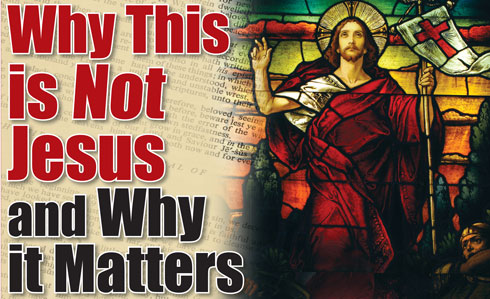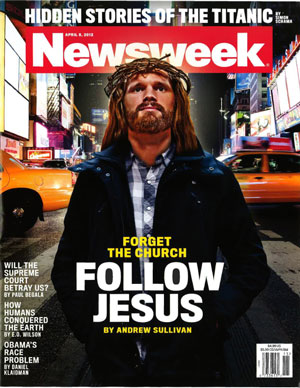Color struck: America's White Jesus is a global export and false product
By Wesley Muhammad, PhD. | Last updated: Dec 24, 2012 - 2:02:15 PMWhat's your opinion on this article?

|
(FinalCall.com) - From the first time Christian children settle into Sunday school classrooms, an image of Jesus Christ is etched into their minds. In North America he is most often depicted as both taller than his disciples, lean, with long, flowing, light brown hair, fair skin and light-colored eyes. Familiar though this image may be, it is inherently flawed. A person with these features and physical bearing would have looked very different from everyone else in the region where Jesus lived and ministered. —Popular Mechanics Magazine, December 2002
***
“Now it doesn’t matter what color Jesus was. If Jesus were actually White, that’s fine. If he were. But he was not … Suppose Jesus looked like you (Black students). You don’t want him now?” —The Honorable Minister Louis Farrakhan at Alabama A&M, April 10, 2012

An April 9th edition of Newsweek magazine.
|
The irony is that most of these same Americans in their heart of hearts are pretty confident any way that they know what color Jesus was. They attend churches with images of a tall, long haired, full bearded White man depicted in stained glass windows or painted on walls, and they return home to the same depictions framed in their living room or illustrating their family Bibles.
Further compounding the irony is the fact that America actually has an obsession with the (presumed) color of Christ and has exported her White Americanized Savior around the world, as recently documented by Edward J. Blum and Paul Harvey in their book, The Color of Christ: The Son of God and the Saga of Race in America (2012).
In fact, the world’s most popular and recognizable image of Christ is a distinctly 19th-20th century American creation. It is true that versions of the “White Christ” appear in European art as early as the 4th century of the Christian era, but these images coexisted with other, nonwhite representations throughout European history. The popularity of the cult of the Black Madonna and Black Christ throughout Europe is evidence of the fact that the European ‘White Christs’ never acquired the authority and authenticity that the White Christ now has globally. This Christ and his authority are American phenomena. As a predominantly Protestant nation Early America rejected the imaging of Christ that characterized European Catholicism.

|
“By wrapping itself with the alleged form of Jesus, whiteness gave itself a holy face … With Jesus as white, Americans could feel that sacred whiteness stretched back in time thousands of years and forward in sacred space to heaven and the second coming … The white Jesus promised a white past, a white present, and a future of white glory.”
As America rose to superpower status in the 20th century she became the world’s leading producer and global exporter of White Jesus imagery through film, art, American business, and Christian missions, and has thereby defined the world’s view of the Son of God. This globally recognizable Jesus is a totally American product. Indeed, he is an American. Warner Sallman’s iconic image of Jesus called Head of Christ (1941) became the most widely reproduced piece of artwork in world history and its depiction the most recognizable face of Jesus in the world. By the 1990s it had been printed over 500 million times and achieved global iconic status. With smooth white skin, long, flowing blondish-brown hair, long beard and blue eyes, this Nordic Christ consciously disguised any hint of Jesus’s Semitic, oriental origin—and departed from the older European depictions. It both shaped and was shaped by emerging American ideas of whiteness. The beloved White Jesus of today’s world was Made in America.
What, then, did Jesus actually look like? Despite the absence of a detailed description of Jesus’s physical appearance in the Gospels (though John the Revelator saw the risen Christ apparently with wooly hair and black feet, Rev. 1:14-15), there are non-biblical evidences that actually allow us to visualize the Son of God from Nazareth.
The first century Jewish writer Josephus (37-100 AD) penned the earliest non-biblical testimony of Jesus. He reportedly had access to official Roman records on which he based his information and in his work Halosis or the “Capture (of Jerusalem),” written around 72 A.D., Josephus discussed “the human form of Jesus and his wonderful works.” Unfortunately his texts have passed through Christian hands which altered them, removing offensive material. Fortunately, however, Biblical scholar Robert Eisler in a classic 1931 study of Josephus’ Testimony was able to reconstruct the unaltered testimony based on a newly-discovered Old Russian translation that preserved the original Greek text. According to Eisler’s reconstruction, the oldest non-Biblical description of Jesus read as follows:
“At that time also there appeared a certain man of magic power … if it be meet to call him a man, [whose name is Jesus], whom [certain] Greeks call a son of [a] God, but his disciples [call] the true prophet … he was a man of simple appearance, mature age, black-skinned (melagchrous), short growth, three cubits tall, hunchbacked, prognathous (lit. ‘with a long face’ [macroprosopos]), a long nose, eyebrows meeting above the nose … with scanty [curly] hair, but having a line in the middle of the head after the fashion of the Nazaraeans, with an undeveloped beard.”

|
This short, black-skinned, mature, hunchbacked Jesus with a unibrow, short curly hair and undeveloped beard bears no resemblance to the Jesus Christ taken for granted today by most of the Christian world: the tall, long haired, long bearded, white-skinned and blue eyed Son of God. Yet, this earliest textual record matches well the earliest iconographic evidence. The earliest visual depiction of Jesus is a painting found in 1921 on a wall of the baptismal chamber of the house-church at Dura Europos, Syria and dated around 235 A.D. The Jesus that is “Healing the Paralytic Man” (Mark 2:1-12) is short and dark-skinned with a small curly afro. This description has now been supported by the new science of forensic anthropology. In 2002 British forensic scientists and Israeli archaeologists reconstructed what they believe is the most accurate image of Jesus based off of data obtained from the multi-disciplinary approach. In December 2002 Popular Science Magazine published a cover story on the findings which confirm that Jesus would have been short, around 5”1’, hair “short with tight curls,” a weather-beaten face “which would have made him appear older,” dark eyes and complexion: “he probably looked a great deal more like a dark-skinned Semite than Westerners are used to seeing,” they concluded. The textual, visual, and scientific evidence agrees, then: Jesus likely was a short, dark-skinned Semite with short curly hair and dark eyes.
Colossians 1:15 describes Christ as the “image of the unseen God” and in the Gospel of John (12:45; 14:9) Jesus declares that whoever sees him has seen God. What Jesus “looks like” then is not irrelevant as it is in some way a pointer to God Himself.
Dr. Wesley Muhammad is an Historian of Religion who earned a Bachelor’s degree (1994) in Religious Studies from Morehouse College and a Master’s degree (2003) and Doctorate (2008) in Islamic Studies from the University of Michigan. He has authored several scholarly studies on the Teachings of the Honorable Elijah Muhammad, including “The Truth of God: The Bible, The Qur’an and the Secret of the Black God” as well as “Black Arabia and the African Origin of Islam.”
Related story:
On Christmas: What Would OUR Jesus Do? (FCN, 12-24-2012)
Black Folks' Guide to Understanding Christmas (FCN, 12-22-2011)
INSIDE STORIES AND REVIEWS
-
-
About Harriett ... and the Negro Hollywood Road Show
By Rabiah Muhammad, Guest Columnist » Full Story -
Skepticism greets Jay-Z, NFL talk of inspiring change
By Bryan 18X Crawford and Richard B. Muhammad The Final Call Newspaper @TheFinalCall » Full Story -
The painful problem of Black girls and suicide
By Charlene Muhammad -National Correspondent- » Full Story -
Exploitation of Innocence - Report: Perceptions, policies hurting Black girls
By Charlene Muhammad -National Correspondent- » Full Story -
Big Ballin: Big ideas fuel a father’s Big Baller Brand and brash business sense
By Bryan Crawford -Contributing Writer- » Full Story






 Click Here Stay Connected!
Click Here Stay Connected!








